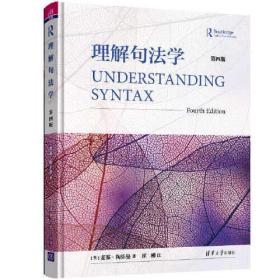
理解句法学第4版
全新正版 极速发货
¥ 67.49 6.8折 ¥ 99 全新
库存3件
广东广州
认证卖家担保交易快速发货售后保障
作者(英)麦基·陶乐曼|责编:曹诗悦
出版社清华大学
ISBN9787302544753
出版时间2020-05
装帧其他
开本其他
定价99元
货号1202094926
上书时间2024-06-19
- 最新上架
商品详情
- 品相描述:全新
- 商品描述
-
目录
Note to the instructor
Note to the student
Acknowledgements
Abbreviations used in examples
Tables and figures
1 What is syntax?
章节导读
1.1 Some concepts and misconceptions
1.1.1 What is the study of syntax about?
1.1.2 Language change
1.2 Use of linguistic examples
1.2.1 Why not just use examples from English?
1.2.2 How to read linguistic examples
1.3 Why do languages have syntax?
1.3.1 Word order
1.3.2 Promotion and demotion processes
1.3.3 All languages have structure
Further reading
Exercises
Notes
2 Words belong to different classes
章节导读
2.1 Identifying word classes
2.1.1 How can we tell that words belong to different classes?
2.1.2 Starting to identify nouns, adjectives and verbs
2.1.3 An illustration: How do speakers of a language identify word classes?
2.2 Verbs
2.2.1 An introduction to verb classes
2.2.2 Verbs and their grammatical categories
2.3 Nouns
2.3.1 Semantic roles for noun phrases
2.3.2 Syntactic roles for noun phrases
2.3.3 Nouns and their grammatical categories
2.3.4 Nouns,definiteness and determiners
2.4 Adjectives
2.4.1 Positions and functions of adjectives
2.4.2 Adjectives and intensifiers
2.4.3 Adjectives and their grammatical categories
2.4.4 Are adjectives essential?
2.5 Adverbs
2.5.1 Adverbs and adjectives
2.5.2 The adjunct function
2.6 Prepositions
2.6.1 Identifying prepositions in English
2.6.2 Postpositions
2.6.3 Grammatical categories for adpositions
2.7 Conclusion
Further reading
Exercises
3 Looking inside sentences
内容摘要
全面涵盖句法学研究的核心内容,历经多次修订,是一本句法学入门教材和句法分析训练教材。
内容全面,结构安排合理:基于转换生成语法理论和思想,讲解层层递进、由浅入深,练习设计丰富,切实训练读者分析问题和解决问题的能力。
实例丰富,语言朴素易懂:将抽象的句法学概念融入一百余种丰富具体的语言
实例中,生动具体地展示句法学基本概念和基本理论。
新增中文章节注和注释:梳理章节核心内容,强化核心概念理解,增强学习效果。
相关推荐
— 没有更多了 —























以下为对购买帮助不大的评价